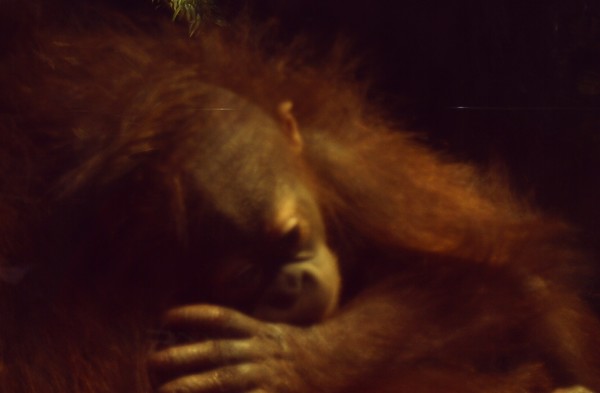- Annamaria McDonald
- View Portfolio
- Image 93 of 116
- Added 12 Aug 2006
- 187 Views
- 12 Comments
- 1 Favorite
- Share This Image On...

This is a new born Baby Bornean Orangutan at the Cleveland Metroparks Zoo. He was laying on his mother. Cleveland Metroparks Zoo welcomed the birth of a male Bornean orangutan (Pongo pygmaeus pygmaeus) on April 11, 2006. The new baby, Daniel, was born to 19-year-old mother Kayla and 20-year-old father Tiram, and is only the third orangutan ever born at the Zoo. He joins a troop that includes five-year-old sister Kitra, seven-year-old adopted sister Kera and adult female Chiquita. They make their home in the domed orangutan exhibit on the second floor of The RainForest. Daniel's birth was no accident. The Species Survival Plan (SSP) of the Association of Zoos & Aquariums (AZA) scientifically matched his parents. The SSP strives to perpetuate a long-term genetically diverse orangutan population through carefully managed breeding. The Bornean orangutan is considered endangered due primarily to habitat loss, and is one of the species managed by the SSP. Description: Head and body are 4.5-5.5 ft. long. Arm-spread is approximately 8.25 ft. with females weighing up to 143 lb. and males weighing up to 317 lb. The are the largest tree-dwelling mammal, and the only great ape living in Asia. The legs are relatively short and weak while the arms are long and powerful.Orangutans are primarily diurnal and arboreal. While not as social as other apes, they may congregate when fruit is abundant. They construct nests high in the trees for sleeping, which are usually only used once. Smaller nests may be made for daytime rests. Orangutans use leafy branches held over their heads or large leaves draped over their head and shoulders as protection from both rain and sun. Tool use among fully wild orangutans does not compare with that of chimpanzees, though captive orangutans released into the wild are quite adept at tool use. Adult males spend over 90% of their time on their own. The interval between births is generally 3-4 years, though it can be as much as 8. Mothers look after their young for up to 8 years. Only human children are dependent longer.
5 of 12 Comments Show All 12 Comments
Bailey Hopper 19 May 2007
Awww, so full of emotion, wonderful!julie Marks 21 Mar 2007
This is amazing. This is such a poignant shot capturing the emotions that primates share with humans. They are our next of kin and should be treasured. Thanks for sharing information in your narrative about these fascinating and wonderul sentient beings.Jean M. Laffitau 11 Feb 2007
Good and touching shot Annamaria!!John Enright 24 Nov 2006
charming and intuitive photograph lady Annamaria... your drawings are also quite charming.Joanne Woolley 07 Nov 2006
Oh Wow! This is so beautiful, you are so lucky you got to see this in reality, I love these beautiful creatures and they are so intelligent they totally fascinate me. You did a wonderful job of capturing this, well done, Joanne:)